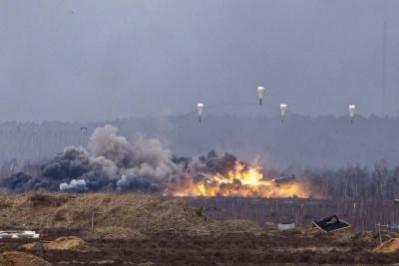
In an unprecedented operation, Ukraine demonstrated the evolving nature of modern warfare with an absolutely secretly planned drone strike targeting Russia's Olenya and Belaya airbases. Located on the Kola Peninsula and deep in Siberia, these facilities house some of Russia's most advanced strategic bombers, including the TU-95MS and TU-22M3, which have frequently been used in missile strikes against Ukraine. Reports indicate that swarms of low-cost drones, launched from civilian trucks strategically placed near the airbases, inflicted devastating damage, destroying approximately 40 aircraft and early warning systems, with the financial toll estimated at $2 billion.
The significance of this attack reverberates far beyond the immediate losses. Occurring just ahead of peace talks scheduled in Istanbul, it challenges Russia's military preparedness and its ability to safeguard critical assets. The strike also raises broader questions about the vulnerability of advanced military systems, the role of asymmetric tactics in modern conflicts, and the geopolitical implications for global security. With experts like retired US General Ben Hodges calling the attack "a masterclass in modern warfare," the incident underscores the transformative power of innovation in the hands of a determined defender.
A Paradigm Shift in Asymmetric Warfare
Ukraine's use of low-cost, high-impact drone swarms signifies a seismic shift in how weaker nations can combat technologically superior adversaries. According to military analyst Dr. Justin Bronk from the Royal United Services Institute, "This operation demonstrates how even low-budget systems, when employed intelligently, can dismantle multi-billion-dollar military infrastructure." The drones, launched from innocuous civilian vehicles parked near gas stations, evaded detection by Russian air defenses, raising concerns about the effectiveness of traditional countermeasures.
This tactical innovation mirrors the evolving doctrine of asymmetric warfare, where speed, stealth, and adaptability outweigh brute force. The destruction of TU-95MS bombers capable of delivering long-range missile strikes represents not only a tactical victory but a symbolic triumph over Russian military dominance. It highlights the vulnerabilities of centralized, high-value assets in a decentralized battlefield.
Psychological and Operational Impact
The attack's psychological impact on Russia cannot be overstated. President Vladimir Putin has frequently boasted of Russia's military invulnerability, but this incident exposes significant gaps in its defenses. Ukrainian Defense Minister Oleksii Reznikov called it "a turning point that proves the Achilles' heel of Russian military infrastructure." Russian state media, usually quick to downplay such events, struggled to control the narrative, with images of burning airbases circulating widely on social media.
Operationally, the loss of aircraft like the A-50 early warning systems significantly hampers Russia's air control capabilities. Military expert Michael Kofman observed that "the ripple effects of losing strategic assets like these extend well beyond Ukraine, potentially reshaping Russia's operational calculus across multiple fronts."
Implications for the Russia-Ukraine Conflict
The Istanbul Peace Talks: An Uneasy Context
The attack's timing complicates the peace talks scheduled in Istanbul. While Russian negotiators, led by Foreign Minister Sergei Lavrov, emphasized the need for dialogue, Ukrainian President Volodymyr Zelensky declared that "real peace can only come when the aggressor is disarmed." This divergence underscores the challenge of reconciling the immediate realities of war with the broader aspirations for peace.
Russia's delegation, however, downplayed the attack, with Kremlin spokesperson Dmitry Peskov stating, "Such provocations will not derail our commitment to finding a diplomatic solution." Yet, the underlying tension is palpable, as both sides seek to leverage recent events to bolster their positions at the negotiating table.

Escalation Risks and Broader Security Concerns
The attack significantly escalates the conflict, raising fears of retaliatory measures from Russia. Analysts speculate that Moscow may intensify missile strikes on Ukrainian infrastructure, potentially widening the scope of the conflict. NATO Secretary General Jens Stoltenberg expressed concern, noting that "an emboldened Ukraine could lead to unintended escalation, further straining the fragile balance of international security."
For neighboring countries like Poland and the Baltic states, the incident underscores the need for heightened vigilance. Estonian Prime Minister Kaja Kallas warned, "This attack shows how easily war can spill over borders if unchecked."
Lessons for Militaries and Political Leadership
Redefining Threat Perceptions
The attack underscores the need for militaries worldwide to reassess their defense postures. Conventional deterrence models, reliant on advanced weaponry and static defenses, are increasingly vulnerable to unconventional tactics. As former NATO Commander Admiral James Stavridis remarked, "The future of warfare is not in the size of your arsenal but in your ability to adapt to evolving threats."
Investment in Counter-Drone Systems
The inadequacy of traditional air defenses against swarming drones highlights an urgent need for advanced counter-drone technology. These systems must integrate AI-driven detection, electronic warfare capabilities, and kinetic interception methods. Israel's Iron Dome system, for instance, provides a model for effective multi-layered defenses, though it too faces challenges against smaller, dispersed threats.
Decentralized Command and Control
The success of Ukraine's operation underscores the importance of decentralization in military strategy. By leveraging civilian infrastructure and decentralized tactics, Ukraine effectively neutralized centralized Russian assets. This approach necessitates a shift in military doctrines, emphasizing flexibility and rapid adaptation.
Implications for Military Industries and Future Conflicts
The Strategic Value of Drones
The attack reaffirms the growing role of drones as force multipliers in modern warfare. Global defense industries must accelerate investments in swarm technology, autonomous navigation, and counter-drone systems. The Stockholm International Peace Research Institute (SIPRI) predicts that the global drone market will surpass $55 billion by 2030, driven by demand for both offensive and defensive applications.
Vulnerability of High-Value Assets
The destruction of strategic bombers highlights the inherent vulnerability of centralized, high-value assets. Militaries may need to prioritize the dispersal and hardening of such assets, investing in mobile platforms and redundant systems to mitigate risks.
Ethical and Legal Considerations
The use of drones in civilian areas raises complex ethical and legal questions. International law must evolve to address these challenges, balancing operational necessity with the principles of humanitarian protection. The United Nations' Group of Governmental Experts on Lethal Autonomous Weapons Systems is currently exploring frameworks to regulate the deployment of such technologies.
Geopolitical Fallout
NATO and Western Support
Ukraine's successful strike will likely strengthen its position among Western allies. US National Security Advisor Jake Sullivan called the operation "a testament to Ukraine's ingenuity and resilience," signaling continued support for Ukrainian defense initiatives. NATO countries may intensify arms transfers and intelligence sharing, reinforcing Ukraine's capabilities.
Russia's Strategic Recalibration
For Russia, the attack necessitates a fundamental reassessment of its military strategy. The exposure of vulnerabilities in its air defenses and the loss of critical assets may prompt a shift in focus from offensive operations to internal security. However, with resources stretched across multiple fronts, such recalibration will be challenging.
Imperatives for India
Strengthening Domestic Defenses
India, as a regional power with significant strategic interests, must draw lessons from this incident. Investments in multi-layered air defense systems, particularly against drones, are imperative. DRDO's work on anti-drone technologies must be accelerated to address emerging threats.
Leveraging Indigenous Innovation
India's burgeoning defense industry must prioritize the development of indigenous drone and counter-drone systems. Collaboration with global partners can enhance technological capabilities while ensuring strategic autonomy.
Navigating Geopolitical Complexities
As a country with deep ties to both Russia and Ukraine, India must navigate these dynamics carefully. Advocating for a peaceful resolution aligns with India's principles, while maintaining defense cooperation with Russia ensures long-term strategic stability.
Conclusion
The Ukrainian drone strike on Russia's strategic airbases is a watershed moment in modern warfare, demonstrating the transformative potential of technology and asymmetric tactics. Beyond the immediate tactical success, the incident reshapes perceptions of military power, highlighting the vulnerabilities of advanced systems in the face of innovative threats.
For global militaries and political leadership, the lessons are clear: adapt to new paradigms, invest in counter-drone capabilities, and rethink traditional defense models. As the Russia-Ukraine conflict evolves, its implications will extend far beyond the battlefield, shaping the future of global security.
India, poised as a key player in this changing landscape, must act decisively to strengthen its defenses, leverage its technological potential, and maintain its geopolitical balance. The time to adapt is now, as the contours of future conflicts take shape before our eyes.
[Major General Dr Dilawar Singh is an Indian Army veteran who has led the Indian Army's Financial Management, training and research divisions introducing numerous initiatives therein. He is the Senior Vice President of the Global Economist Forum AO ECOSOC, United Nations and The Co President of the Global Development Bank.]











